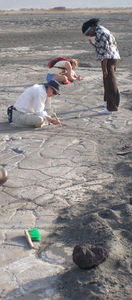
"While the site has been known for years, our team was the first to begin an organized investigation of these footprints. They are amazing,' said Dr. Cynthia Liutkus, an assistant professor in Appalachian's Department of Geology.
Liutkus made the first public announcement about the site at the East African Association of Paleoanthropology and Paleontology Conference in August in Arusha, Tanzania. "We wanted to make the announcement in Tanzania before anywhere else," Liutkus said.
Liutkus is one of several members of the Ngare Sero Project, the group of international scientists and conservationists working to investigate and preserve the footprint site in northern Tanzania.
She was accompanied by senior geology major Kate McGinnis who received funding from the Explorer's Club in New York as well as Appalachian's Office of Student Research to go on the trip. McGinnis assisted the research team and collected data and samples for her senior thesis project that will involve chemically analyzing the ash layer in which the footprints are pressed to determine its volcanic source.
"Researching in a place that doesn't have enough clean water for its people is difficult, but being able to show those same people the footprints of their ancestors is an amazing experience," McGinnis said.
Similar to the Laetoli footprints that also are in Tanzania but are about 3.2 million years old and attributed to the early human species Australopithecus afarensis, the Ngare Sero footprints are pressed into an ash layer that has been radiometrically dated to be approximately 120,000 years old. Given that modern fossil and genetic evidence points to the evolution of modern humans (Homo sapiens) in Africa around 200,000 years ago, this makes the Ngare Sero footprints the oldest known trackways of our modern ancestors.
While there are other sites, specifically in South Africa, that contain footprints of ancient Homo sapiens, they do not contain discrete and traceable trackways of multiple individuals like the Ngare Sero site. Of the 58 prints uncovered this summer, there appear to be at least three different individuals that can be identified based on the size measurements of the footprints, and several of the trackways can be traced for large distances. The smallest footprints of perhaps a female or juvenile are arranged in a trackway that continues for more than 12 meters and contains 18 individual prints.
Liutkus is collaborating with scientists and researchers from the Smithsonian Institution, the American Museum of Natural History, the Pennsylvania Institute for Conservation Education (PICE), Rutgers University, and the Tanzania Department of Antiquities.
"With the data we collected this summer, we hope to reconstruct the height, weight, and gait of the individuals that made these traces, and determine which nearby volcano produced the footprinted ash layer," Liutkus said.
Funding for Liutkus' summer research was provided by Appalachian's College of Arts and Sciences, PICE and Global Rescue.
The Ngare Sero project members announced a partnership with the Tanzanian Department of Antiquities as well as the Ngare Sero Village Council, to preserve and conserve this spectacular heritage site in northern Tanzania.
"Since the ash unit is exposed in the bed of a seasonal river, it is crucial that we quickly devise a conservation plan in order to protect this site," Liutkus stated. "The director of the Department of Antiquities and other members of the Tanzanian government have visited the site and are fully committed to ensuring its safety."
This year marks the 50th anniversary of Mary Leakey's discovery of the famous Zinjanthropus skull - one of the best preserved fossils of the species Australopithecus boisei - at Olduvai Gorge, Tanzania, in 1959. Since that time, Tanzania has long been viewed as the Cradle of Humankind, due to its incredible paleoanthropological record.



Reader Comments
to our Newsletter